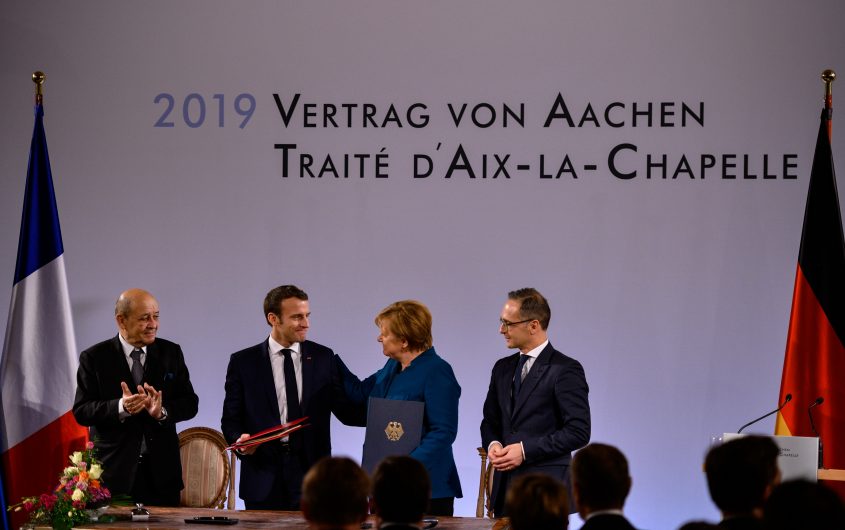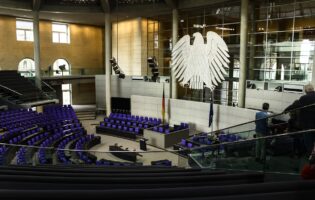
Sascha Schuermann/Getty Images
From Fear to Friendship: Franco-German Relations in 1949 and 2019

Lily Gardner Feldman
Senior Fellow
Dr. Lily Gardner Feldman is a Senior Fellow at AICGS. She previously served as the Harry & Helen Gray Senior Fellow at AICGS and directed the Institute’s Society, Culture & Politics Program. She has a PhD in Political Science from MIT.
From 1978 until 1991, Dr. Gardner Feldman was a professor of political science (tenured) at Tufts University in Boston. She was also a Research Associate at Harvard University’s Center for European Studies, where she chaired the German Study Group and edited German Politics and Society; and a Research Fellow at Harvard University’s Center for International Affairs, where she chaired the Seminar on the European Community and undertook research in the University Consortium for Research on North America. From 1990 until 1995, Dr. Gardner Feldman was the first Research Director of AICGS and its Co-director in 1995. From 1995 until 1999, she was a Senior Scholar in Residence at the BMW Center for German and European Studies at Georgetown University. She returned to Johns Hopkins University in 1999.
Dr. Gardner Feldman has published widely in the U.S. and Europe on German foreign policy, German-Jewish relations, international reconciliation, non-state entities as foreign policy players, and the EU as an international actor. Her latest publications are: Germany’s Foreign Policy of Reconciliation: From Enmity to Amity, 2014; “Die Bedeutung zivilgesellschaftlicher und staatlicher Institutionen: Zur Vielfalt und Komplexität von Versöhnung,” in Corine Defrance and Ulrich Pfeil, eds., Verständigung und Versöhnung, 2016; and “The Limits and Opportunities of Reconciliation with West Germany During the Cold War: A Comparative Analysis of France, Israel, Poland and Czechoslovakia” in Hideki Kan, ed., The Transformation of the Cold War and the History Problem, 2017 (in Japanese). Her work on Germany’s foreign policy of reconciliation has led to lecture tours in Japan and South Korea.
For the last seventy years, the Franco-German “couple” has constituted the center of European integration and peace in Europe. Reflection on the early stage of the relationship and on contemporary ties allows us to see just how far the Franco-German partnership has come and whether it is resilient enough to steer the European project today.
Then
In the first five years of the postwar period, French officialdom displayed a punitive attitude toward Germany, occasioned by France’s deep resentment over its defeat in 1940 and the subsequent “viciousness” of German occupation. French public opinion shared politicians’ hatred with only a minority of 10 to 20 percent expressing trust in Germany. Nonetheless, significant segments of French society, particularly the churches, offered the hand of forgiveness, foreshadowing the central role civil society in the two countries would go on to play in the overall process of reconciliation.
By 1950 there was a softening of official Franco-German relations due to two factors: the onset of the Cold War; and the vision of French and German leaders. Chancellor Konrad Adenauer saw the absolute centrality of the Franco-German tandem for Europe’s future, as expressed in the first months of the Federal Republic’s founding: “Franco-German conflict, which dominated European history for centuries and caused so many wars and so much destruction […] must be eliminated once and for all.”[1] Reflecting on his January 1950 meeting with French foreign minister Robert Schuman, Adenauer wrote: “Franco-German reconciliation and understanding was already my goal in the 1920s.”[2] Just a few months later, Adenauer readily acceded to Schuman’s plan for a European Coal and Steel Community with Franco-German partnership as its centerpiece. Yet, French politicians’ antipathy toward Germany and fear of Germany’s remilitarization scuttled the hopes for a European Defense Community (proposed in October 1950 by French prime minister René Pleven) when the Assemblée Nationale failed to ratify the treaty in 1954.
Germany’s self-limitation was accompanied by the French goal of containing German power in both economic and military terms.
Germany soon opted for a multilateralist path that signaled cooperation and commitment in the hallmark Western institutions: the North Atlantic Treaty Organization (NATO) in May 1955 and the European Economic Community (EEC) in March 1957. Germany’s self-limitation was accompanied by the French goal of containing German power in both economic and military terms. Together, they would be jointly responsible for all manner of policy choices and initiatives in the European Community and the European Union: economic and monetary union, common foreign policy and defense, and constitutional issues, making the Franco-German duo what Chancellor Angela Merkel has called “the motor” of Europe.
A structural approach was also taken in bilateral relations where the two sides crafted a panoply of institutions in both governmental and societal arenas from economics to defense, from culture to science. Much of this institutional structure was codified in the January 1963 Elysée Treaty, which recognized the reality of reconciliation and sought to expand it. Thereafter, institutions channeled cooperation and contained conflict.
And Now
In January 2019, France and Germany “renewed their marriage vows” in the Treaty of Aachen, whose goals were two-fold: to intensify the two countries’ cooperation, including in economics, climate issues, foreign affairs, defense, and external and internal security; and to expand Europe’s capacity to act independently in the twenty-first century. In concrete terms, bilaterally France and Germany envisage a common economic zone; a council of economic experts; a cross-border cooperation committee; a citizens’ fund to support town twinnings and cross-border initiatives; expanded youth exchange (through which nine million young people have spent time in the other country); a mutual defense clause; a common military culture; as well as joint programs in energy, renewable energy, and energy efficiency.
At the European level, the treaty reemphasizes the central aims of free trade and completion of the single market, commits to social and economic convergence and solidarity, promises to expand common and security policy, and indicates that they will consult on all EU issues in advance with the goal of common positions on all important EU decisions.
The goals of the new treaty are as ambitious as those of the 1963 treaty, but the environment the two countries face is much less hospitable.
The goals of the new treaty are as ambitious as those of the 1963 treaty, but the environment the two countries face is much less hospitable. Domestically, both countries face institutionalized populism and nationalism. Regionally, there are internal challenges within the EU, which could intensify if anti-EU parties end up in the European Parliament, and a reluctance on the part of smaller member states to automatically follow the Franco-German lead. Globally, the international environment is highly unpredictable with respect to the actions of established powers such as the U.S., Russia, and China and the intentions of organized non-state actors.
In evaluating the potential for success of the Aachen treaty, some observers identify the range of issues on which France and Germany disagree: Brexit; arms exports; climate policy, for example. However, the passage of reconciliation from 1949 to 2019 is studded with examples where there are large conflicts but the reality of compromises after thorough discussion and debate. It is not an easy process of coming to agreement but a reliable one. Merkel recently noted that the two countries “wrestle” with their differences, especially as “there are different mentalities between us.” President Emmanuel Macron has referred to their relationship as “productive confrontation,” the outcome of which is “to reach compromise.”
France and Germany have several factors in their favor in charting a way forward for bilateral relations and for Europe: the habit of cooperation over seven decades and the commitment and passion of its two leaders to address the challenges. What they do not have is time. Merkel is on her way out and Macron faces pressure from all directions at home. In the late 1940s and early 1950s, the capacity for France and Germany to embark on a path from fear to friendship and for Europe to begin its new trajectory of peace depended on leadership. That quality is in notably short supply once Merkel and Macron are gone.
[1] Auswärtiges Amt, 40 Jahre Aussenpolitik der Bundesrepublik. Eine Dokumentation (Stuttgart: Verlag Bonn Aktuell, 1989), 23.
[2] Konrad Adenauer, Erinnerungen, 1945-1953 (Frankfurt am Main: Fischer Bücherei, 1967), 246.
Read more on the 70th anniversary of the Federal Republic of Germany
Seventy Years as a Country of Immigrants: What’s Next for Germany? by Susanne Dieper
From Bonn to Berlin: Seventy Years of the FRG by Jackson Janes
Sovereignty Regained, Economic Order Uncertain: Germany’s Social Market Economy at 70 by Peter Rashish
The 70th Anniversary of the Federal Republic of Germany: Challenges and Opportunities for the German-American Future and the Atlantic Community by Jeff Rathke
The Past Shapes the Future: The German Constitution at 70 by Stephen F. Szabo









